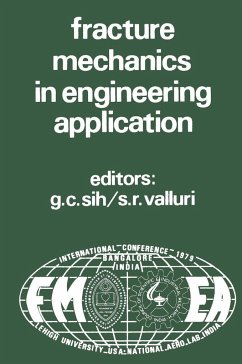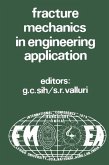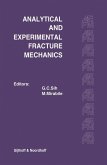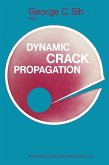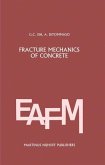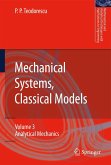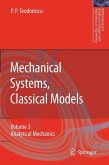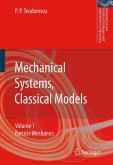SihHeld at the National Aeronautical Laboratory Bangalore, India March 26-30, 1979
Proceedings of an International Conference on Fracture Mechanics in Engineering Application
Held at the National Aeronautical Laboratory Bangalore, India March 26-30, 1979
Herausgegeben:Sih, George C.; Valluri, S. R.
SihHeld at the National Aeronautical Laboratory Bangalore, India March 26-30, 1979
Proceedings of an International Conference on Fracture Mechanics in Engineering Application
Held at the National Aeronautical Laboratory Bangalore, India March 26-30, 1979
Herausgegeben:Sih, George C.; Valluri, S. R.
- Gebundenes Buch
- Merkliste
- Auf die Merkliste
- Bewerten Bewerten
- Teilen
- Produkt teilen
- Produkterinnerung
- Produkterinnerung
The International Conference on Fracture Mechanics in Engineering Applica tion convened at the r~ational Aeronautical Laboratory (NAL) in Bangalore, India, March 26-30, 1979, with the presence of approximately 400 scientists and engi neers. The participants included individuals from all parts of India, United States of America, United Kingdom, Japan, Holland, France, Hong Kong, Korea, Sweden and Poland. The Conference was organized jointly by NAL, Bangalore;and Lehigh University, USA. Various organizations in India have also supported the Conference most generously. Professor S. Dhawan,…mehr
Andere Kunden interessierten sich auch für
![Proceedings of an international conference on Fracture Mechanics in Engineering Application Proceedings of an international conference on Fracture Mechanics in Engineering Application]() Proceedings of an international conference on Fracture Mechanics in Engineering Application153,99 €
Proceedings of an international conference on Fracture Mechanics in Engineering Application153,99 €![Proceedings of an international conference on Analytical and Experimental Fracture Mechanics Proceedings of an international conference on Analytical and Experimental Fracture Mechanics]() Proceedings of an international conference on Analytical and Experimental Fracture Mechanics229,99 €
Proceedings of an international conference on Analytical and Experimental Fracture Mechanics229,99 €![Proceedings of an international conference on Dynamic Crack Propagation Proceedings of an international conference on Dynamic Crack Propagation]() Proceedings of an international conference on Dynamic Crack Propagation77,99 €
Proceedings of an international conference on Dynamic Crack Propagation77,99 €![Fracture mechanics of concrete: Structural application and numerical calculation Fracture mechanics of concrete: Structural application and numerical calculation]() G.C. Sih / A. Ditomasso (Hgg.)Fracture mechanics of concrete: Structural application and numerical calculation153,99 €
G.C. Sih / A. Ditomasso (Hgg.)Fracture mechanics of concrete: Structural application and numerical calculation153,99 €![Mechanical Systems, Classical Models Mechanical Systems, Classical Models]() Petre P. TeodorescuMechanical Systems, Classical Models150,99 €
Petre P. TeodorescuMechanical Systems, Classical Models150,99 €![Mechanical Systems, Classical Models Mechanical Systems, Classical Models]() Petre P. TeodorescuMechanical Systems, Classical Models149,99 €
Petre P. TeodorescuMechanical Systems, Classical Models149,99 €![Mechanical Systems, Classical Models Mechanical Systems, Classical Models]() Petre P. TeodorescuMechanical Systems, Classical Models150,99 €
Petre P. TeodorescuMechanical Systems, Classical Models150,99 €-
The International Conference on Fracture Mechanics in Engineering Applica tion convened at the r~ational Aeronautical Laboratory (NAL) in Bangalore, India, March 26-30, 1979, with the presence of approximately 400 scientists and engi neers. The participants included individuals from all parts of India, United States of America, United Kingdom, Japan, Holland, France, Hong Kong, Korea, Sweden and Poland. The Conference was organized jointly by NAL, Bangalore;and Lehigh University, USA. Various organizations in India have also supported the Conference most generously. Professor S. Dhawan, Director of the Indian Institute of Science and Secre tary of Department of Space, delivered the inaugural speech. He said that the advance of science was the precondition of the development and survival of human society in the modern world. "It is true that in recent times, science and tech nology - and their practitioners - have been subjected to much public scrutiny, debate and severe criticism". On the other hand, the depletion of non-renewable resources, degradation of the natural environment and a host of other problems had been laid at the door of technology and science. One cannot deny that funda mental advances in the physics and chemistry of the structure of matter had led to spectacular engineering progress. Advanced technologies like nuclear energy and space exploration were but expression of the central role of computors, elec tronics, optics, polymers, etc. , and all of these were heavily dependent on the successful application of material science and technology.
Produktdetails
- Produktdetails
- Verlag: Springer / Springer Netherlands
- Artikelnr. des Verlages: 978-90-286-0719-4
- 1979.
- Seitenzahl: 890
- Erscheinungstermin: 31. Dezember 1979
- Englisch
- Abmessung: 234mm x 156mm x 46mm
- Gewicht: 1390g
- ISBN-13: 9789028607194
- ISBN-10: 9028607196
- Artikelnr.: 26563045
- Herstellerkennzeichnung
- Libri GmbH
- Europaallee 1
- 36244 Bad Hersfeld
- gpsr@libri.de
- Verlag: Springer / Springer Netherlands
- Artikelnr. des Verlages: 978-90-286-0719-4
- 1979.
- Seitenzahl: 890
- Erscheinungstermin: 31. Dezember 1979
- Englisch
- Abmessung: 234mm x 156mm x 46mm
- Gewicht: 1390g
- ISBN-13: 9789028607194
- ISBN-10: 9028607196
- Artikelnr.: 26563045
- Herstellerkennzeichnung
- Libri GmbH
- Europaallee 1
- 36244 Bad Hersfeld
- gpsr@libri.de
Section I Ductile Fracture.- Mechanics of crack growth: Geometrical size effect in fracture.- Ductile fracture of aluminum tensile specimens.- Plane stress slip-line fields for crack-tip plastic zones in thin-sheet materials.- Strip yielding model and fracture toughnesses of thin and tough plates.- Near tip fields in a cracked plate according to deformation theory.- Analytical and finite element considerations of certain linear and nonlinear aspects of fracture mechanics.- Effects of stress triaxiality on ductile fracture initiation and ductile-brittle transition in prestrained steel.- Comparison of theoretical and experimental results pertaining to R-curves in low and high ductility solids.- Section II Fracture of Metal Alloys.- Elevated temperature strength and fracture toughness determinations of sintered alpha silicon carbide.- Fracture toughness measurements by microfractographic method of common constructional steels.- Influence of microstructure on fatigue crack propagation in aluminium - zinc - magnesium alloys.- Fracture toughness of spheroidal graphite cast iron.- A metallurgical study of electron beam welding of sintered iron.- Improvement in fracture toughness of AISI 4340 steel through electroslag refining.- Section III Fatigue.- On the influence of cyclic loading on the metallurgical stability of type 304 stainless steel at elevated temperatures.- A method for constant amplitude fatigue crack propagation data correlation.- A simple generalised model for fatigue crack propagation.- Engineering application of fracture mechanics to flight simulation fatigue crack propagation.- Initiation and growth of fatigue crack in cylindrical specimens of carbon steels under rotary bending loads.- Residual deformations in the vicinity of a fatigue crack tip.- An analytical derivation of fatigue damage criterion for ASCR stranded conductors.- A new method of arresting fatigue crack growth by artificial wedge.- Section IV Composite and Fatigue.- An engineering approach to static and fatigue behavior of flawed fiber-composite laminates.- Fatigue behaviour prediction for carbon fibre reinforced plastics.- Control of crack propagation in metals by the use of composites.- Crack growth behavior at the boundary of composed materials.- Section V Composite Materials.- Aramid Fiber Composites.- Punching shear and penetration characteristics of some fiber reinforced composites.- Fracture resistance of random fiber glass composites.- Mixed mode fracture in orthotropic media.- Problems of fatigue in composite members.- On the behaviour of cracks in laminated composite panels.- Effect of surface and adhesive preparation on the fracture mode of aluminium-epoxy bonded specimens.- Section VI Engineering Fracture Problems.- Geothermal energy: Thermomechanics of heat extraction from hot, dry rock masses.- Fracture mechanics of brick masonry.- Forced vibration of a fluid-filled hydraulic fracture.- Fracture behaviour of a high tension bolt material.- Failure analysis of engineering components.- Fracture behaviour of high-speed grinding wheels.- On the interaction of geological fractures and mining induced fractures.- Section VII Experimental and Testing Methods.- Reactor Vessel nozzle cracks; a photoelastic study.- Fracture strength of pre-cracked charpy beams.- A secant compliance method for calculating plane strain fracture toughness in medium strength steel.- Fractographic features in 12 cr steels.- Application of Kikukawa's compliance method to part-through crack growth at the root of a notch.- Section VIII Analytical Modeling.- Energy balanceconsiderations during stable crack growth.- The brittle fracture of cutting tools.- On a new cumulative damage model for fatigue.- Initiation and quasi-static extension of fracture in viscoelastic media (experiment versus theory).- Plastic energy dissipation rate during stable crack growth in a plate of finite thickness under biaxial loading.- Section IX Numerical Analysis.- The fictitious crack model and its use in numerical analyses.- Analysis of dynamic problems of cracks in anisotropic solids by a finite difference method (The AWMP code).- A mixed finite element for accurate crack tip stress analysis.- Determination of stress intensity factors using mixed elements.- Section X Stress Analysis.- Apex singularities for corner cracks under opening, sliding, and tearing modes.- On a model of thermal cracks.- Effect of cracks in solids.- Stress intensity factors of an infinite row of pair of Griffith cracks whose faces are loaded asymmetrically.- On the bending stress distribution at the tip of a stationary crack from Reissner's theory.- Thermal stress in dissimilar media with a crack.- Section XI Structure Applications.- Characterization of fracture toughness at crack extension by developed deformation; in particular, for linepipe steels, comparison with energy balance considerations.- The application of fracture mechanics to welded structures.- Propagation of edge cracks in laterally excited stiffened panels.- Fracture mechanics in relation to failure in masonry dams.- Application of fracture mechanics to crack growth damage in pavements.- List of Participants.
Section I Ductile Fracture.- Mechanics of crack growth: Geometrical size effect in fracture.- Ductile fracture of aluminum tensile specimens.- Plane stress slip-line fields for crack-tip plastic zones in thin-sheet materials.- Strip yielding model and fracture toughnesses of thin and tough plates.- Near tip fields in a cracked plate according to deformation theory.- Analytical and finite element considerations of certain linear and nonlinear aspects of fracture mechanics.- Effects of stress triaxiality on ductile fracture initiation and ductile-brittle transition in prestrained steel.- Comparison of theoretical and experimental results pertaining to R-curves in low and high ductility solids.- Section II Fracture of Metal Alloys.- Elevated temperature strength and fracture toughness determinations of sintered alpha silicon carbide.- Fracture toughness measurements by microfractographic method of common constructional steels.- Influence of microstructure on fatigue crack propagation in aluminium - zinc - magnesium alloys.- Fracture toughness of spheroidal graphite cast iron.- A metallurgical study of electron beam welding of sintered iron.- Improvement in fracture toughness of AISI 4340 steel through electroslag refining.- Section III Fatigue.- On the influence of cyclic loading on the metallurgical stability of type 304 stainless steel at elevated temperatures.- A method for constant amplitude fatigue crack propagation data correlation.- A simple generalised model for fatigue crack propagation.- Engineering application of fracture mechanics to flight simulation fatigue crack propagation.- Initiation and growth of fatigue crack in cylindrical specimens of carbon steels under rotary bending loads.- Residual deformations in the vicinity of a fatigue crack tip.- An analytical derivation of fatigue damage criterion for ASCR stranded conductors.- A new method of arresting fatigue crack growth by artificial wedge.- Section IV Composite and Fatigue.- An engineering approach to static and fatigue behavior of flawed fiber-composite laminates.- Fatigue behaviour prediction for carbon fibre reinforced plastics.- Control of crack propagation in metals by the use of composites.- Crack growth behavior at the boundary of composed materials.- Section V Composite Materials.- Aramid Fiber Composites.- Punching shear and penetration characteristics of some fiber reinforced composites.- Fracture resistance of random fiber glass composites.- Mixed mode fracture in orthotropic media.- Problems of fatigue in composite members.- On the behaviour of cracks in laminated composite panels.- Effect of surface and adhesive preparation on the fracture mode of aluminium-epoxy bonded specimens.- Section VI Engineering Fracture Problems.- Geothermal energy: Thermomechanics of heat extraction from hot, dry rock masses.- Fracture mechanics of brick masonry.- Forced vibration of a fluid-filled hydraulic fracture.- Fracture behaviour of a high tension bolt material.- Failure analysis of engineering components.- Fracture behaviour of high-speed grinding wheels.- On the interaction of geological fractures and mining induced fractures.- Section VII Experimental and Testing Methods.- Reactor Vessel nozzle cracks; a photoelastic study.- Fracture strength of pre-cracked charpy beams.- A secant compliance method for calculating plane strain fracture toughness in medium strength steel.- Fractographic features in 12 cr steels.- Application of Kikukawa's compliance method to part-through crack growth at the root of a notch.- Section VIII Analytical Modeling.- Energy balanceconsiderations during stable crack growth.- The brittle fracture of cutting tools.- On a new cumulative damage model for fatigue.- Initiation and quasi-static extension of fracture in viscoelastic media (experiment versus theory).- Plastic energy dissipation rate during stable crack growth in a plate of finite thickness under biaxial loading.- Section IX Numerical Analysis.- The fictitious crack model and its use in numerical analyses.- Analysis of dynamic problems of cracks in anisotropic solids by a finite difference method (The AWMP code).- A mixed finite element for accurate crack tip stress analysis.- Determination of stress intensity factors using mixed elements.- Section X Stress Analysis.- Apex singularities for corner cracks under opening, sliding, and tearing modes.- On a model of thermal cracks.- Effect of cracks in solids.- Stress intensity factors of an infinite row of pair of Griffith cracks whose faces are loaded asymmetrically.- On the bending stress distribution at the tip of a stationary crack from Reissner's theory.- Thermal stress in dissimilar media with a crack.- Section XI Structure Applications.- Characterization of fracture toughness at crack extension by developed deformation; in particular, for linepipe steels, comparison with energy balance considerations.- The application of fracture mechanics to welded structures.- Propagation of edge cracks in laterally excited stiffened panels.- Fracture mechanics in relation to failure in masonry dams.- Application of fracture mechanics to crack growth damage in pavements.- List of Participants.

